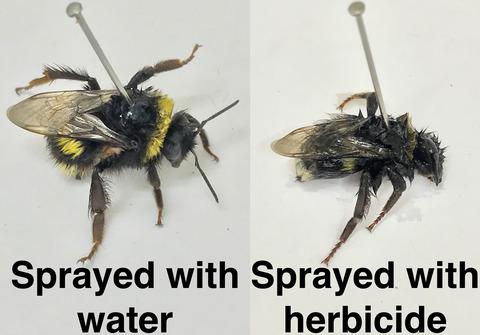当前位置:
X-MOL 学术
›
J. Appl. Ecol.
›
论文详情
Our official English website, www.x-mol.net, welcomes your
feedback! (Note: you will need to create a separate account there.)
Roundup causes high levels of mortality following contact exposure in bumble bees
Journal of Applied Ecology ( IF 5.0 ) Pub Date : 2021-04-06 , DOI: 10.1111/1365-2664.13867 Edward A. Straw 1 , Edward N. Carpentier 1 , Mark J. F. Brown 1
中文翻译:

大黄蜂接触暴露后农达导致高死亡率
更新日期:2021-06-02
Journal of Applied Ecology ( IF 5.0 ) Pub Date : 2021-04-06 , DOI: 10.1111/1365-2664.13867 Edward A. Straw 1 , Edward N. Carpentier 1 , Mark J. F. Brown 1
Affiliation

|
- Pollinators underpin global food production, but they are suffering significant declines across the world. Pesticides are thought to be important drivers of these declines. Herbicides are the most widely applied type of pesticides and are broadly considered ‘bee safe’ by regulatory bodies who explicitly allow their application directly onto foraging bees. We aimed to test the mortality effects of spraying the world's most popular herbicide brand (Roundup®) directly onto bumble bees Bombus terrestris audax.
- We used three Roundup® products, the consumer products Roundup® Ready-To-Use and Roundup® No Glyphosate, the agricultural product Roundup® ProActive, as well as another herbicide with the same active ingredient (glyphosate), Weedol®. Label recommended pesticide concentrations were applied to the bees using a Roundup® Ready-To-Use spray bottle.
- Bees exhibited 94% mortality with Roundup® Ready-To-Use® and 30% mortality with Roundup® ProActive®, over 24 hr. Weedol® did not cause significant mortality, demonstrating that the active ingredient, glyphosate, is not the cause of the mortality. The 96% mortality caused by Roundup® No Glyphosate supports this conclusion. Dose-dependent mortality caused by Roundup® Ready-To-Use, further confirms its acute toxicity. Roundup® products caused comprehensive matting of bee body hair, suggesting that surfactants, or other co-formulants in the Roundup® products, may cause death by incapacitating the gas exchange system.
- These mortality results demonstrate that Roundup® products pose a significant hazard to bees, in both agricultural and urban systems, and that exposure of bees to them should be limited.
- Synthesis and applications. Surfactants, or other co-formulants, in herbicides and other pesticides may contribute to global bee declines. We recommend that, as a precautionary measure until co-formulant identities are made public, label guidelines for all pesticides be altered to explicitly prohibit application to plants when bees are likely to be foraging on them. As current regulatory topical exposure toxicity testing inadequately assesses toxicity of herbicide products, we call for pesticide companies to release the full list of ingredients for each pesticide formulation, as lack of access to this information hampers research to determine safe exposure levels for beneficial insects in agro-ecosystems.
中文翻译:

大黄蜂接触暴露后农达导致高死亡率
- 授粉媒介是全球粮食生产的基础,但它们在世界范围内正在遭受显着下降。农药被认为是这些下降的重要驱动因素。除草剂是应用最广泛的杀虫剂类型,被监管机构广泛认为是“蜜蜂安全的”,明确允许将其直接应用于觅食蜜蜂。我们的目的是测试喷涂世界上最流行的除草剂品牌(综合报道的死亡率影响®)直接到熊蜂熊蜂蒺藜奥达斯。
- 我们使用了三种农达®产品,即消费品农达®即用型和农达®无草甘膦、农产品农达® ProActive 以及另一种具有相同活性成分(草甘膦)的除草剂 Weedol ®。使用Roundup ®即用型喷雾瓶将标签推荐的农药浓度施用于蜜蜂。
- 在 24 小时内,Roundup ® Ready-To-Use ® 的蜜蜂死亡率为 94% ,Roundup ® ProActive ® 的死亡率为 30% 。Weedol ®没有导致显着的死亡率,这表明活性成分草甘膦不是导致死亡的原因。农达®无草甘膦导致的 96% 死亡率支持这一结论。Roundup ® Ready-To-Use引起的剂量依赖性死亡率进一步证实了其急性毒性。Roundup ®产品导致蜜蜂体毛全面消光,表明Roundup ®中的表面活性剂或其他助剂 产品,可能会导致气体交换系统失能而导致死亡。
- 这些死亡率结果表明,农达®产品对农业和城市系统中的蜜蜂构成重大危害,应限制蜜蜂接触这些产品。
- 合成与应用。除草剂和其他杀虫剂中的表面活性剂或其他助剂可能导致全球蜜蜂数量减少。我们建议,作为一项预防措施,直到共同配方的身份公开,所有农药的标签指南都应该修改,明确禁止在蜜蜂可能以植物为食的植物上使用。由于当前监管局部暴露毒性测试未能充分评估除草剂产品的毒性,我们呼吁农药公司发布每种农药制剂的完整成分清单,因为无法获得这些信息阻碍了确定农业有益昆虫安全暴露水平的研究- 生态系统。











































 京公网安备 11010802027423号
京公网安备 11010802027423号